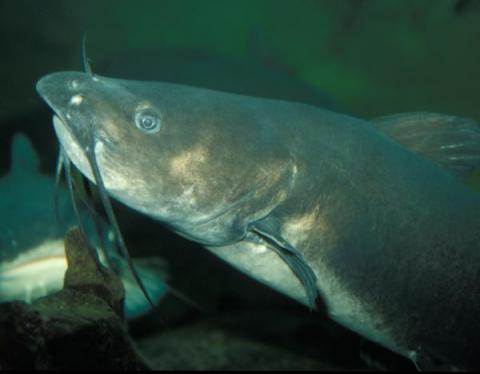Channel Catfish, one of Missouri's most popular sport and food fish, have been stocked in ponds throughout the state. Many small ponds are managed exclusively for channel catfish.
A small, well-managed pond can produce 300 to 500 pounds of catfish per surface acre each year, providing many hours of recreation and an abundance of high quality food for the table.
Channel catfish have scaleless, cylindrical bodies with soft fins, except for the dorsal and pectoral fins, which have hard, sharp spines that can inflict a painful wound. A catfish’s color varies, depending on water clarity. In clear water, catfish may appear dark blue or black, while in muddy water they may be a light yellow or gray. Young channel catfish are typically spotted.
Channel catfish eat a variety of both plant and animal matter. Young catfish, sometimes called fiddlers, feed primarily on aquatic insects, snails, crawfish, green algae, aquatic plants, seeds and small fish. Channel catfish also readily accept commercial pelleted food.
Catfish grow best in warm water, with optimum growth occurring at about 85 degrees Fahrenheit.
Channel catfish become sexually mature at three to four years of age. Once mature, the catfish are spurred to spawn as the water temperature reaches 75 to 80 F. When this happens, the male will seek out and prepare a nest site in a secluded, semi-dark area. The female spawns only once per year, though she will sometimes pair before she is ready to spawn. After spawing, the eggs usually take eight days to hatch and another eight days for the fry to prepare to leave the nest. During this time, the male will first protect the eggs, then the fry until they leave the nest.
Ponds for Catfish
Ponds suitable for exclusive channel catfish production should be at least eight feet deep with pond edges sloping quickly to three feet deep to reduce aquatic vegetation problems. For new ponds, soil characteristics should be identified to assess water- holding capabilities.
All trees and debris should be removed from the dam and basin area to assure a good seal and to allow seining of the pond. A turndown drainpipe could also be installed to allow water level reduction and easier harvesting of fish.
Remove logs and other objects that provide cavities for spawning to discourage natural reproduction of catfish, which could affect the growth of the newly stocked fish in the pond. Existing fish populations will also need to be removed from the pond to decrease competition and allow maximum growth. Information concerning intensive channel catfish production can be obtained from the Missouri Fish Farmers Association or your county Extension Agent. For more information on pond construction and preparation, contact the Natural Resources Conservation Service. If you need advice about removing existing fish populations or determining pond water quality, contact the Missouri Department of Conservation.
Title
Stocking
Getting a good start to a catfish pond requires an adequate initial stocking of fingerling fish (four to six inches in length). Ponds should be stocked in the spring when water temperatures are below 65 degrees in order to reduce stress on the fish. The number of catfish stocked will depend on whether or how often you will feed the catfish.
If you will not feed the fish or will only occasionally feed them, the pond should be stocked at the rate of 100 to 300 fish per surface acre. If you do not plan to feed the catfish, it is a good idea to get the stocking off to a good start by providing forage in the ponds before introducing the catfish. An ideal forage would be fathead minnows stocked at a rate of about 1,000 per surface acre.
Channel catfish that will be fed daily in ponds that depend solely upon surface water run-off with no aeration system can be stocked at a maximum rate of 500 four- to six-inch fingerlings per surface acre.
Title
Feeding
Both floating and sinking pellets are available for catfish feeding. Floating feed allows you to easily determine the correct amount of feed per day (the amount the fish will consume in about 15 minutes). You can also determine size and health of the fish by observing them as they feed. Floating pellets, however, are more expensive than sinking pellets.
Title
Harvesting
Channel catfish purchased from a commercial source may be harvested from your pond or lake with a variety of methods including seines, traps, trotlines or jugs. However, the most enjoyable method of harvest is by hook and line.
You can lure catfish with a variety of commercial baits commonly called “stink baits,” prepared from blood, cheese and dough. Simply form the bait around a treble hook and allow it to sit on the pond bottom. Other good baits include chicken liver and entrails, beef heart and, the angler’s old standby, worms. Fishing is usually most productive in early morning and late evening.
Angling will only produce a partial harvest. If a larger number of catfish, or all the catfish, need to be removed, the pond must be drained or seined.
Lower the pond level down to three or four feet deep and surround the fish with a seine. The seine should be made of polyethylene or treated nylon to prevent catfish spines from tangling in the mesh. Delay harvesting fish if the pond is extremely turbid or a heavy algal bloom is present to avoid problems with “off-flavor” fish.
If your pond is not equipped with a drain, seining provides a good method of removal. A lift net or seine can be placed on the pond bottom in the feeding area, with one edge attached to the shore and the other attached to pulleys on stakes in the pond.
For additional information on Stocking, Harvesting and Feeding, download the full Aquaguide.






















